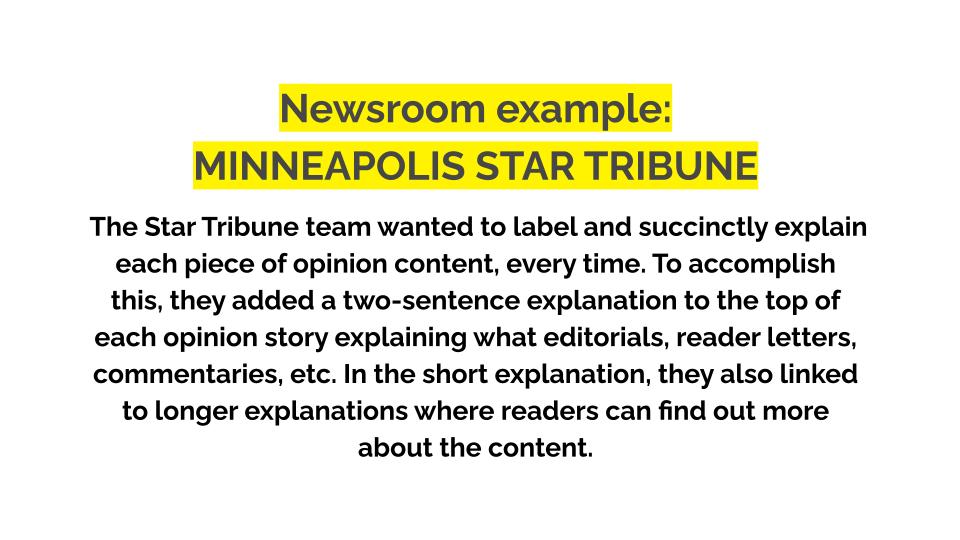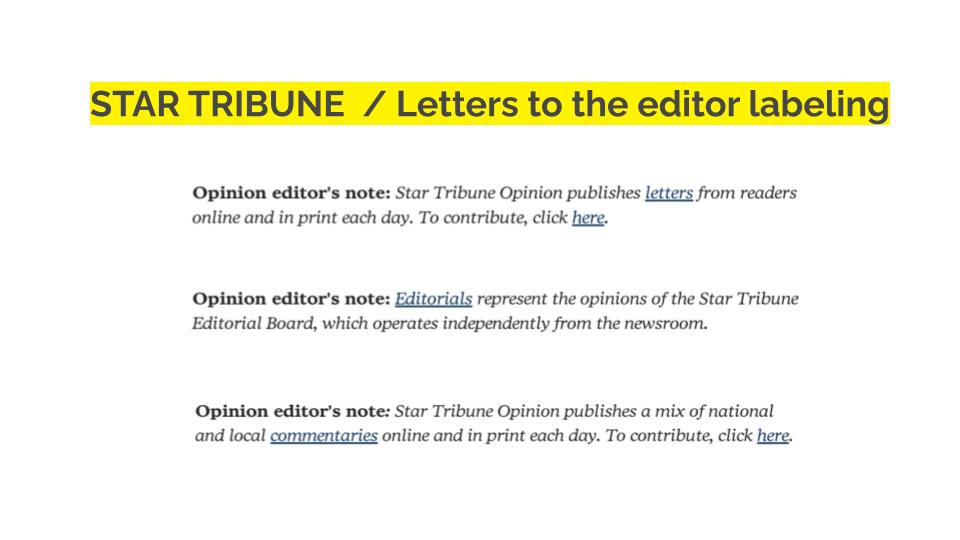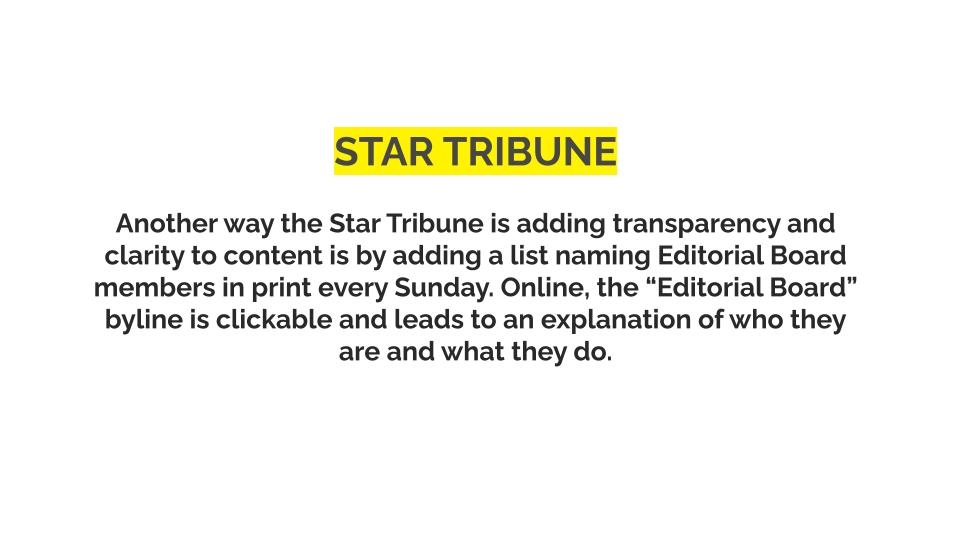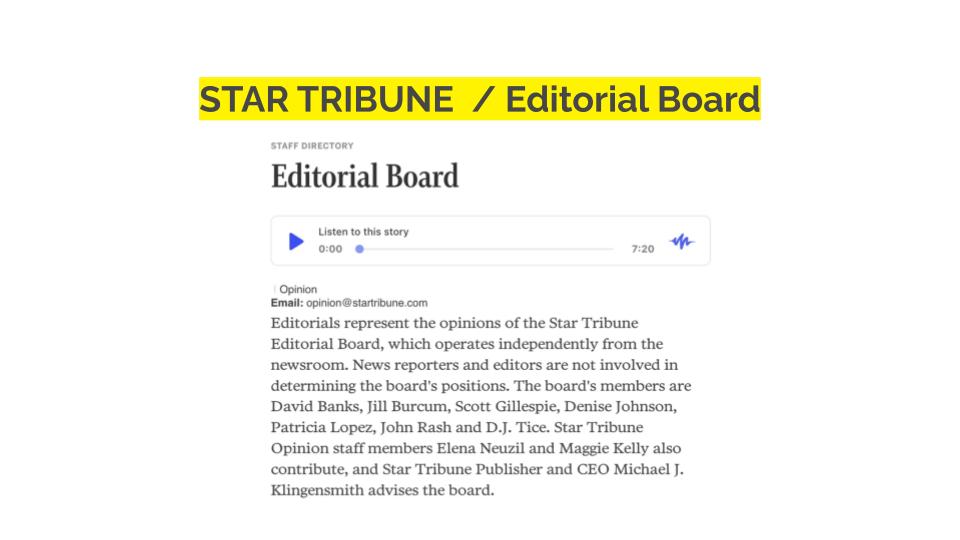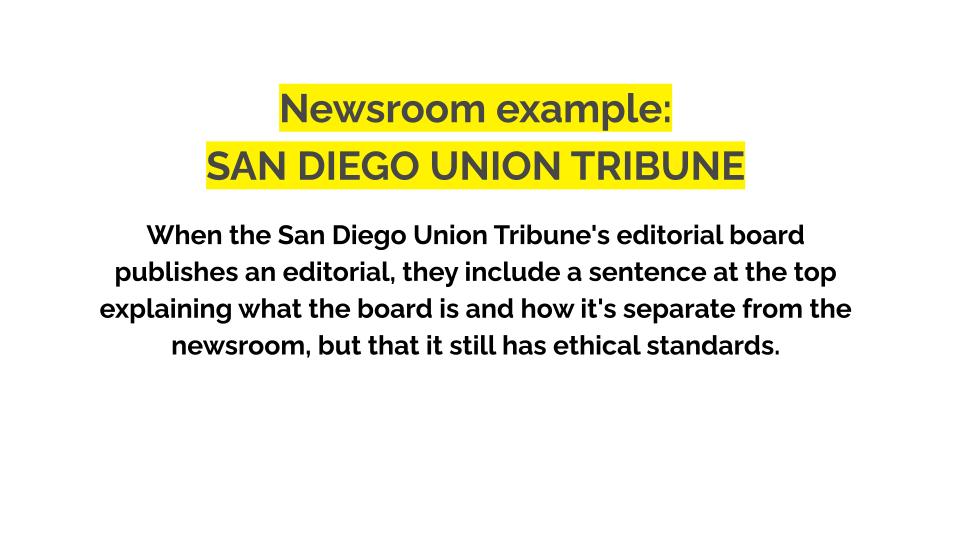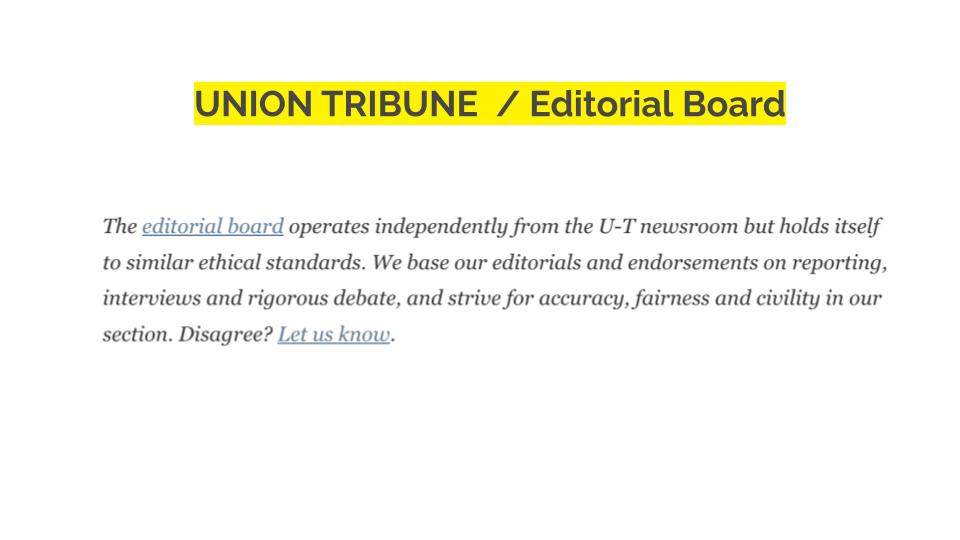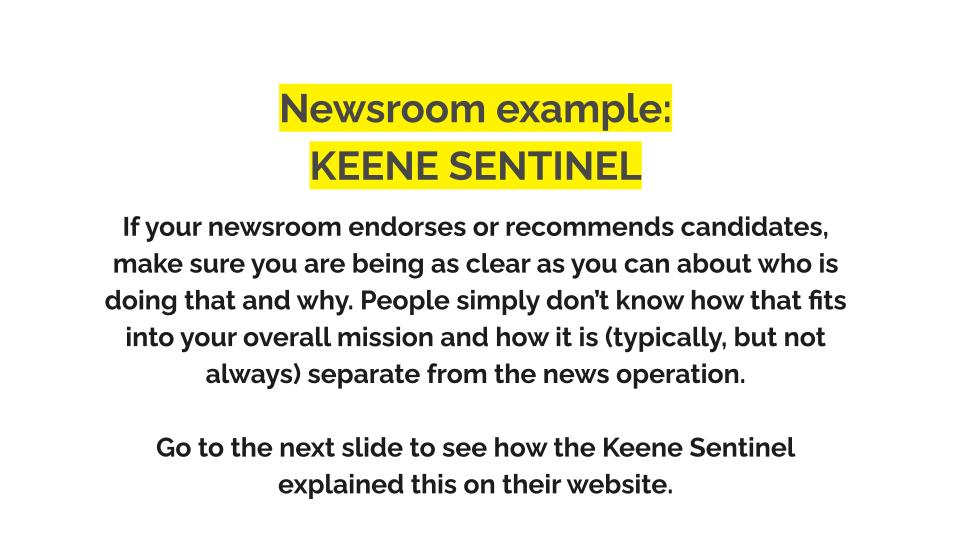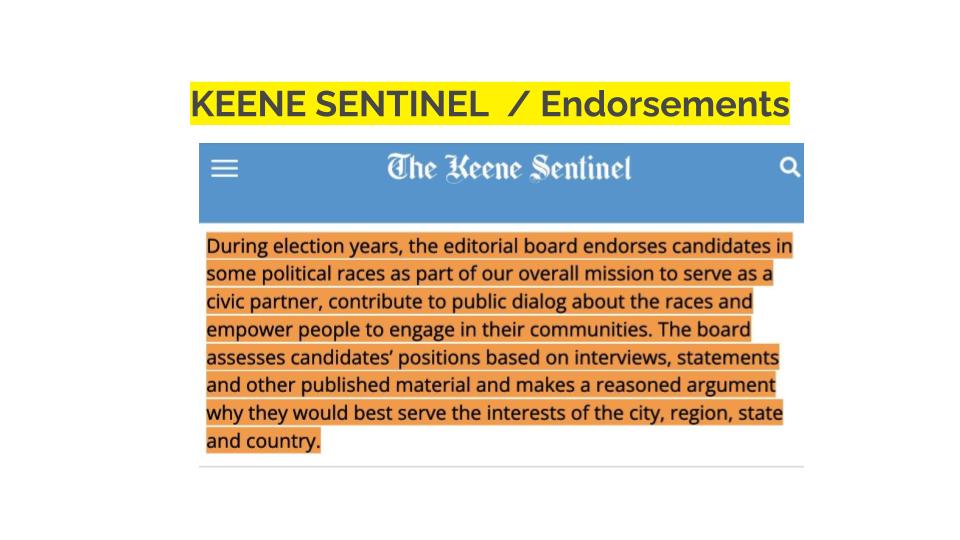HOW NEWS WORKS
Labeling opinion content
“There’s too much opinion in the news!” We’ve all heard it, over and over.
Sometimes, the observation is valid, right? It’s not hard to find examples of where journalists’ own perspectives and assumptions show up in their news reporting. (Sometimes that’s appropriate and transparent, and sometimes it’s careless or accidental.) It’s also not hard to find examples of news sources irresponsibly pretending to be straightforward while actually pushing a perspective.
But sometimes, the complaint is based on people actually not being able to tell opinion content from news content. And that can be for good reason. Across platforms, users simply can’t always tell when journalists are sharing their opinions on purpose — when the opinion is the point of a piece rather than an accidental insertion. More on that is here from Professor Kevin Lerner and here from Kevin Loker at the American Press Institute. As we heard in one newsroom partner’s audience survey: “Change the restaurant reviewer; she’s very biased.”
It does not serve journalists or audiences for that confusion to linger. We simply must be clear — with every piece of content, on every platform — when sharing an opinion is the point of a piece of journalism.
Our ingrained newsroom routines and our tech limitations are insufficient reasons to let there be confusion around opinion content — especially as it fuels so much distrust.
It’s time to make some changes.

Goals
It’s simple, really. We want newsrooms to be clear internally about whether each individual piece of content features the journalist’s own opinions or experiences. And if it does, we want the author and their intent to be crystal clear to the audience, on any platform or environment in which they are exposed to it.
This is especially important for earning the trust of less experienced news consumers. How easy would it be for a casual or first-time audience member to understand that a piece of content is sharing an opinion or perspective, and whose opinion or perspective it is?
Ask yourself if your product is designed for your most loyal consumers or if you want it to be welcoming and accessible to people who are unfamiliar with news conventions in general and with your product specifically.
This Trust Kit helps you:
- Assess how clearly labeled your opinion content is
- Examine your best practices around sharing opinion content
- Help you explain your goals and process for opinion content
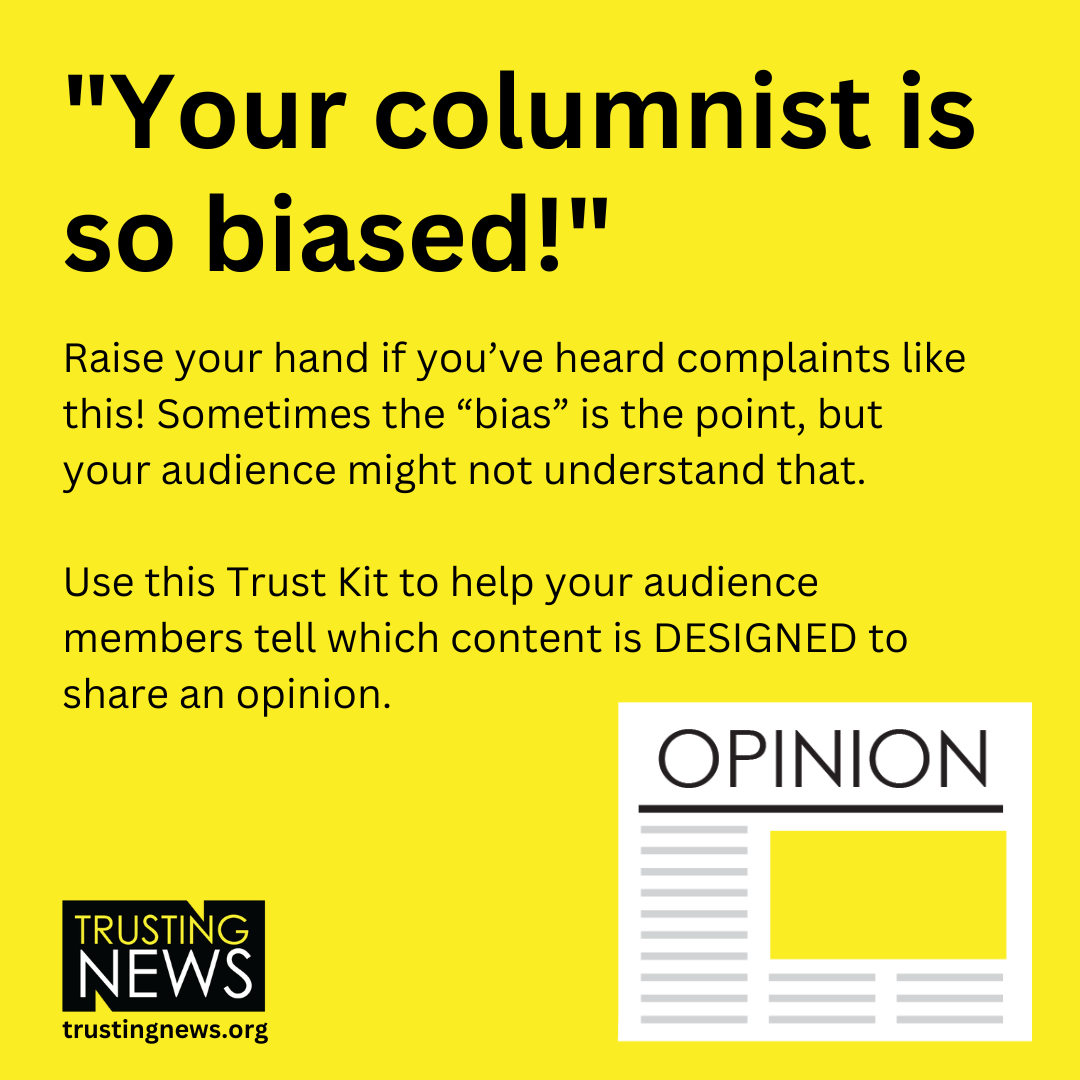

Strategies
Strategy: Use the word “opinion”
We have to make sure we are labeling our content and using words the public will understand. The words “editorial” and “op-ed” are not good enough. Journalists know what those words mean, but not all users do.
If you decide to use other words like “editorial” or “explainer” or “analysis,” it’s smart to also include a description of what that content is in an editor’s note at the top of the article or in another standing spot like a side rail. It’s not a good idea to rely on a tagline at the bottom of the story, as scroll depth data typically shows that a very small percentage of readers make it to the end.
Also rethink the common practice of having the first word of a headline on a column be the columnist’s name, with that as the only indication that the piece is sharing a personal opinion or reflection. That doesn’t translate for anyone who’s not already familiar with the author’s work.
Strategy: Make sure the label follows the story
Even when we think we’re being clear with our labeling, too often, the label doesn’t follow the story on all platforms. It might appear above a headline on our website but not appear at all when the headline is fed into a social site or news app.
Try adding the word “opinion,” followed by a colon, to the front of your headline. Some content management systems will allow different headlines to be written for different platforms, which can give newsrooms the option to adjust the level of clarity needed.
Another option is to have a standard practice of adding the word opinion to the text of social posts or the captions of video or audio clips.
Watch the below video to learn more best practices around labeling opinion content.
Strategy: Explain whose opinion it is
Is this opinion from a journalist who’s paid to share their opinion? Is it from a community contributor? Is it from an expert source or activist? Is it from a wire service? Where is the opinion coming from?
EDITORIAL BOARDS: Have a page explaining what your editorial board is and who is on it. Link to that page from the byline. When you describe the mission of the board, don’t beat around the bush when explaining what the relationship is between your editorial board and your newsroom. If your editorial board is completely separate from your newsroom, say that clearly.
REGULAR COLUMNISTS: Newsrooms often use the word “column” to refer to a wide range of content — a regular sports columnists, a political analysis, a community subject-matter expert, etc. For staff journalists who are paid to share their opinions, it’s important to make it clear that the opinion is intentional. It’s a feature, not a bug. It’s also a good idea to include a bio for each author, explaining who the person is, whether they’re on staff, and what about their expertise, job role, credibility, etc., is relevant to their content.
COMMUNITY-SUBMITTED OPINIONS: For letters to the editor, guest columns and other content from your community, we recommend having a note at the top of a story explaining who the author is. Is the person writing in her capacity as a private citizen? A subject matter expert? A public official? It’s also a good idea to have a page explaining your process for these submissions, and then link to that page from the description at the top of each story. For example, if you accept a guest column about supporting local trails you could write:
“Nelle Jones is a resident of Denver who has been hiking in the metro area for 25 years. Do you have a perspective to share? Learn more about how we handle guest opinion submissions.”
Strategy: Explain your goals and process
Why do you have an opinion section? What is the mission? Are you on the record explaining what role opinion journalism plays? It’s a good idea to be on the record about these issues (rather than assuming the answers are obvious!). Consider adding it to your opinion landing page or creating an FAQ.
You could also address specific content goals. Are you looking for a diversity of voices and perspectives? If so, what does that look like to you?
This could also be a good spot to explain how you handle opinion submissions from the community. Make it clear how someone can contribute and what your process is. For example:
- Do you solicit these pieces, or reach out for counterarguments before or after running them?
- Do you edit the submissions? Do you fact-check them?
- Will you call to verify authorship?
- Do you handle submissions from expert sources (like academics or public officials) differently than you do the ones from regular people?
- Do you pay for submissions?
- How do you decide which submissions to publish?

Take action
Start by assessing your current practices and identifying areas for improvement
What words are you using? Are you consistent across all your content? How do your labels travel to different social platforms and apps? Can people tell who an author behind opinion content is and what their role or expertise is?
We have a printable, step-by-step guide to auditing your own opinion content. It will walk you through our checklists and help you determine what needs to change in your own products.
Make the case in your newsroom that change is necessary.
Journalists are creatures of habit, and change can be difficult. Through this process, you might come across practices that fall into the “because we’ve always done them this way” category. You might have a column that started as a blog and has retained formatting and labeling from an old system. You might have two columnists who perform similar functions but are packaged or described in really different ways because they are managed by different editors.
With opinion content, you might face the added obstacle that authors feel personally connected to the brand or personality they have been accustomed to sharing with the community. They might feel like they are more universally known in the community than they are and that their background or purpose don’t need explaining.
To get buy-in:
- Be ready to explain to staff why this matters so much and how it contributes to correcting misassumptions about journalism overall. (Remember, people think there’s too much opinion in their actual news coverage. It’s vital that we at least make sure they know when they’re getting our opinions on purpose.
- If debates or conflicts arise within the newsroom, let the tie-breaker vote go to the new reader. How likely is it that someone new to town would understand the signals you think you’re giving them about what type of content they’re consuming?
- Be sure to involve colleagues with expertise in design, product and audience engagement. Invite them to be the voice of the audience experience. Better yet, invite some community members not familiar with your work to share their perceptions of mockups or examples.
See how other newsrooms do it
For some inspiration, here are some examples of how newsrooms are labeling and explaining opinion content. For more newsroom examples, check our our newsroom example database.

We’re here to help!
Congratulations on getting this far in the Trust Kit! 🎉 We know taking the steps to earn trust isn’t always simple or easy. It takes time and often requires a shift in newsroom routines or workflows.
Any progress you make on implementing strategies in this Trust Kit should be celebrated as a win!


